I recently purchased some Wharfedale Triton speakers off eBay, with the intention of refurbishing them as a learning exercise. Essentially a practice pair of speakers, to learn how to clean the grille cloth, rewire and re-cap, that kind of thing. They came with a captive speaker cable that was terminated with a two pin DIN plug. Without thinking, I just chopped those off, as the little amplifier I use to test things only takes bare wire. I naively assumed that there would be some +ve / -ve type marking on the crossover circuit board inside, which it turns out there isn’t.
Here's the speakers in question:
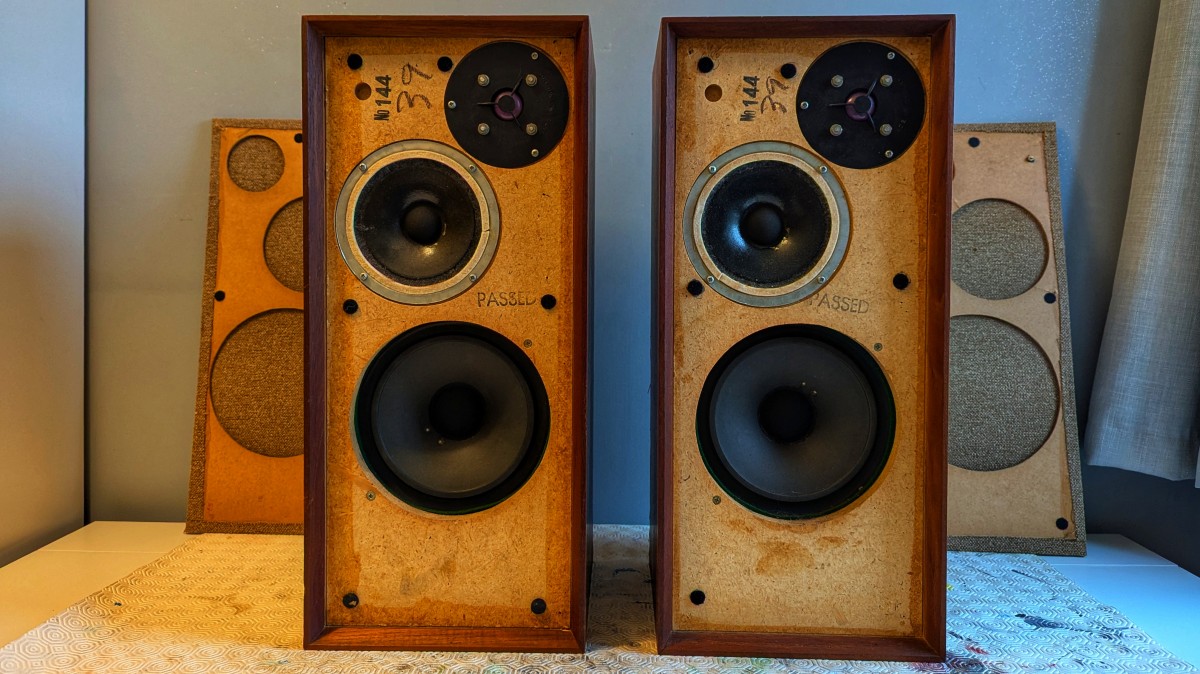
A top view of the crossover, note that two of the inductors are missing any indication of value:
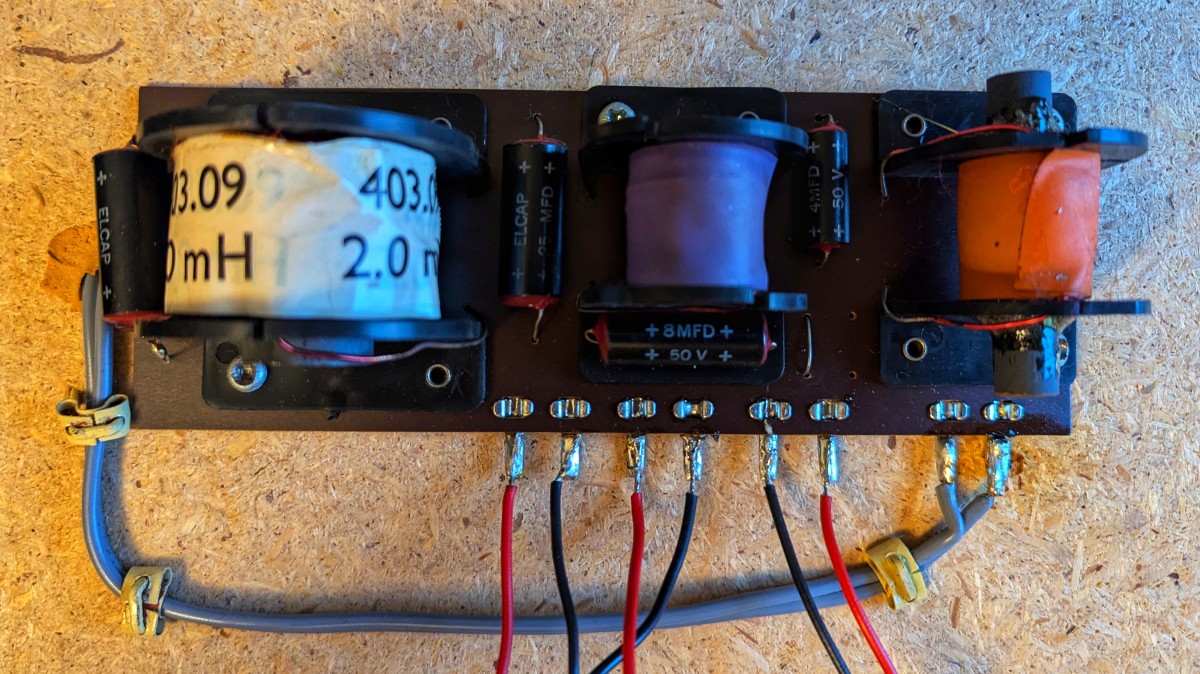
A mirrored view of the bottom of the crossover after I'd de-soldered all the leads:
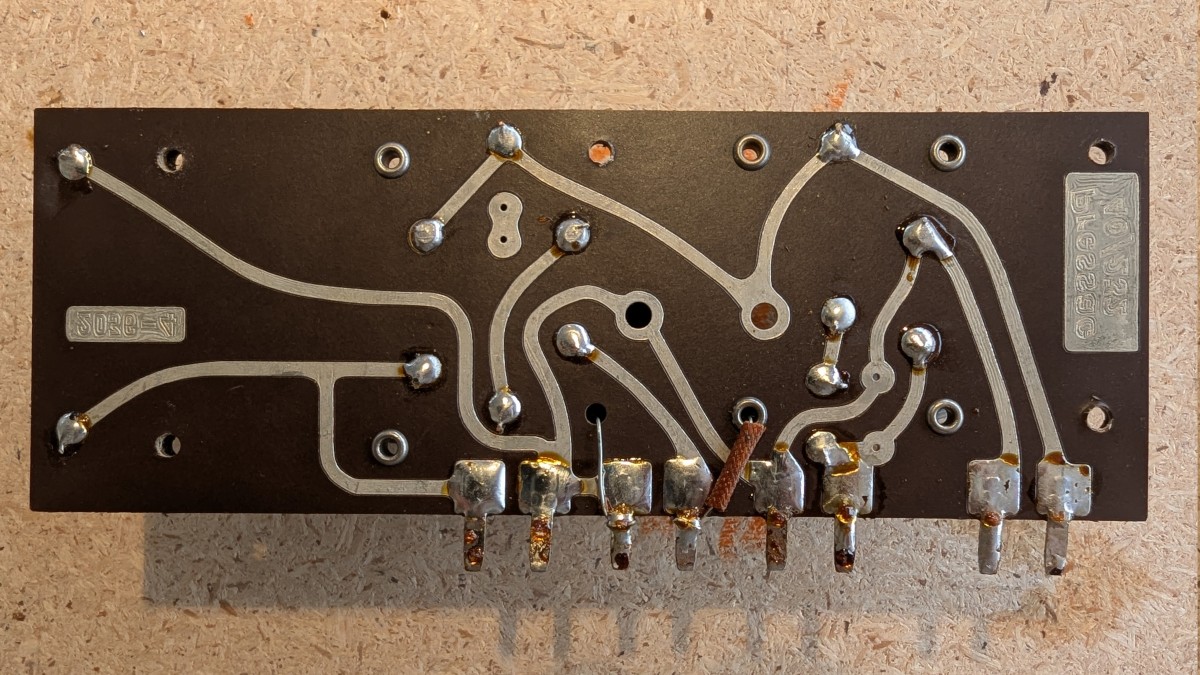
I took some photos and attempted to try and understand the circuit, so I could determine the correct pins to wire up to some proper terminal posts. I started on a whiteboard, then tried to convert that into a “proper” circuit diagram. I’m new to all of this kind of thing, and am not sure that I’ve used all the correct symbols and terminology on the diagram; I would welcome some feedback on that.
My whiteboard circuit:
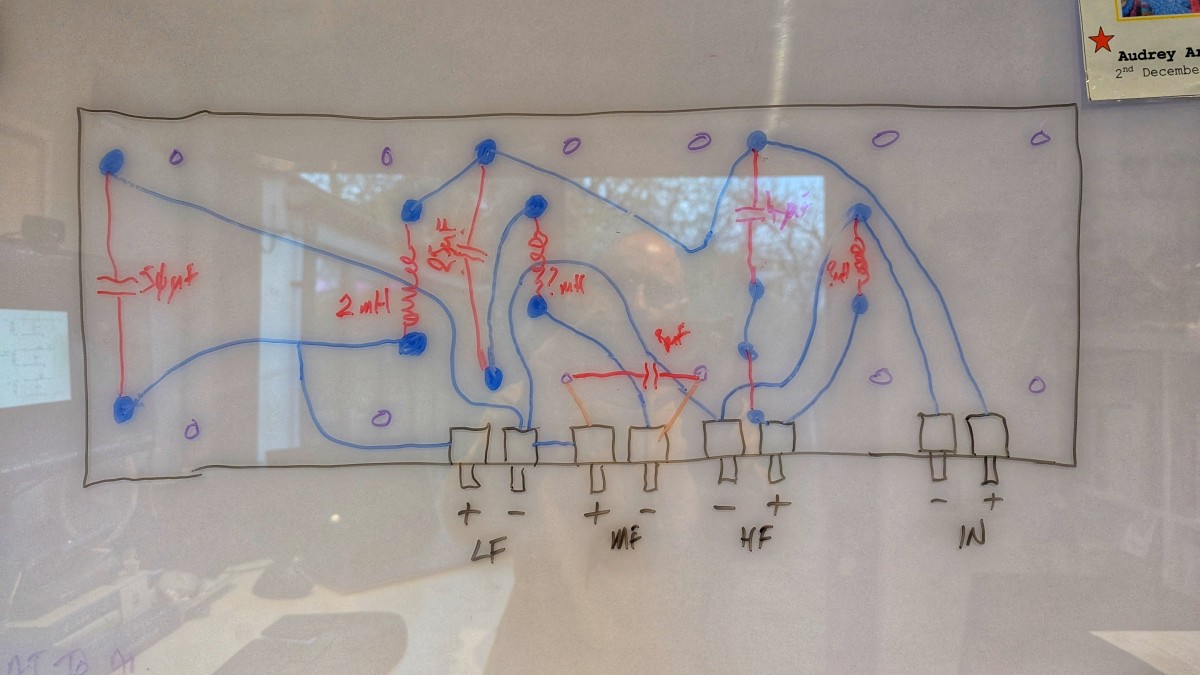
And the resulting circuit diagram:
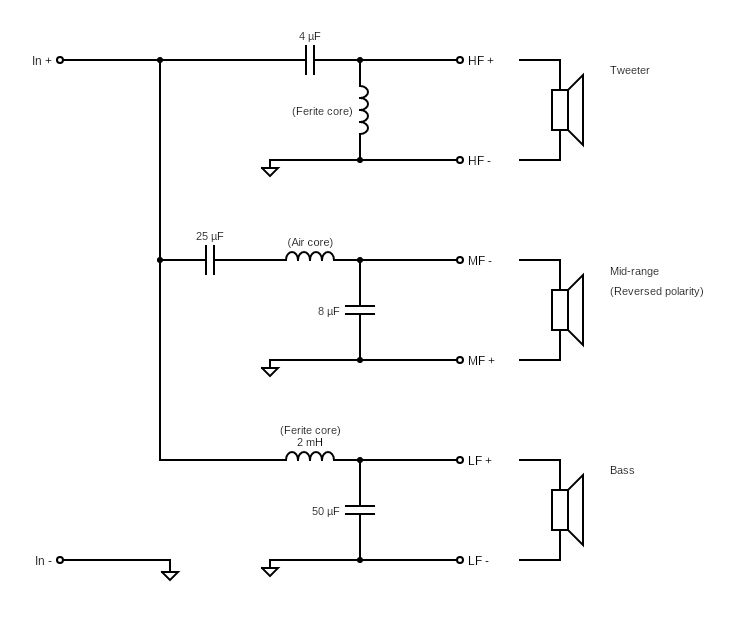
Could someone please confirm whether my circuit diagram is accurate…? Specifically, I would like to verify that I have correctly identified the positive and negative input terminals on the circuit board. That would be the right most tab being the positive input, and the one to it's left, being the negative input.
Cheers,
Bob.
Here's the speakers in question:

A top view of the crossover, note that two of the inductors are missing any indication of value:

A mirrored view of the bottom of the crossover after I'd de-soldered all the leads:

I took some photos and attempted to try and understand the circuit, so I could determine the correct pins to wire up to some proper terminal posts. I started on a whiteboard, then tried to convert that into a “proper” circuit diagram. I’m new to all of this kind of thing, and am not sure that I’ve used all the correct symbols and terminology on the diagram; I would welcome some feedback on that.
My whiteboard circuit:

And the resulting circuit diagram:

Could someone please confirm whether my circuit diagram is accurate…? Specifically, I would like to verify that I have correctly identified the positive and negative input terminals on the circuit board. That would be the right most tab being the positive input, and the one to it's left, being the negative input.
Cheers,
Bob.
Last edited:
Looks like it's spot on. The -ve trace runs without a break between all inputs and outputs, and it is indeed the 'inner' trace of the two.
The + tab does not connect to any output directly, only via other components. You seem to have identified it correctly.
The flipped orientation of the midrange is also correct for that crossover.
The + tab does not connect to any output directly, only via other components. You seem to have identified it correctly.
The flipped orientation of the midrange is also correct for that crossover.
That's a relief! 😅Looks like it's spot on. The -ve trace runs without a break between all inputs and outputs, and it is indeed the 'inner' trace of the two.
Thanks for confirming that, puts my mind at ease somewhat.
My basic understanding of this crossover is that, for the tweeter and woofer at least, they're 2nd order. I'm not sure I understand the configuration of the components and how they form a bandpass filter for the midrange driver? Given it's inverted, it must also be a second order filter though?
I was assuming there would be a combination of the inverse of the existing high pass and low pass filters. I.e. a capacitor followed by an inductor to ground, then an inductor followed by a capacitor to ground. I get that half of that seems to be there, I don't understand how the initial capacitor on it's own works with the classic low pass filter that follows it. Can someone point me to a source somewhere that would explain that kind of thing for me?
Cheers,
Bob.
The effect of the filters combines with the natural tendency of the midrange not to produce bass nor treble. That can be analysed in a similar way to the filters themselves. When you see this kind of asymmetry when there's also been an obvious attempt to filter in the crossover, you might assume that it's the combination that works differently than expected.
The target acoustic slope is what matters, not the electrical layout. It is possible to have a 2nd order slope with a single series component (it often may be the case if the crossover slope is close to the driver's own rolloff). It is also possible that the company was cheaping out, but it is usually not the case for brands like Wharfedale.
Unfortunately I cannot presume to predict crossover topology from looking at a circuit diagram. It is possible to get a 4th order slope with just two components (Zaph's old site has a lot of examples of this kind of topoplogy, the L18 is a good example of this specific instance).
Sorry, @AllenB posted while I was off drinking tea with an active draft. He is right in this instance.
Unfortunately I cannot presume to predict crossover topology from looking at a circuit diagram. It is possible to get a 4th order slope with just two components (Zaph's old site has a lot of examples of this kind of topoplogy, the L18 is a good example of this specific instance).
Sorry, @AllenB posted while I was off drinking tea with an active draft. He is right in this instance.
Thanks for the answers both, although I’m not sure I fully understand what you’re trying to convey. So, correct me if I’m wrong, but this is what I’m thinking you’re trying to tell me:
The reason there isn’t a classical band-pass filter for the mid-range driver, is essentially down to a number of factors. The influence of the other high and low pass filters in the circuit. The driver's natural tendency to reproduce only a certain range of frequencies, within the constraints of its enclosure. And finally, I’m also assuming some sort of testing where they considered the sound good enough, within the financial bounds of the development process.
Is that about right…?
The reason there isn’t a classical band-pass filter for the mid-range driver, is essentially down to a number of factors. The influence of the other high and low pass filters in the circuit. The driver's natural tendency to reproduce only a certain range of frequencies, within the constraints of its enclosure. And finally, I’m also assuming some sort of testing where they considered the sound good enough, within the financial bounds of the development process.
Is that about right…?
You notice there are no resistor, so the serie resistance of the new caps should be near for refurbishing. Alcap can be found easily, any chemical bipolar for loudspeaker filter are okay too.
Try to find the information about the tweeter : Ferrofluided or not ? If yes, it should be rotten and dry now.
Try to find the information about the tweeter : Ferrofluided or not ? If yes, it should be rotten and dry now.
Got you, the over simplification was appreciated!If the mid doesn't like producing highs and lows and you filter them anyway, you'll take away too much of the highs and lows (oversimplified).
I've already sourced replacement capacitors from Falcon Acoustics, although I had to get 4.2μF rather than 4μF for the tweeter. I couldn't find anywhere selling 4μF capacitors in anything other than the more expensive film types. As for ferrofluid, evidently the old Wharfedale purple tweeters are ferrofluid free.You notice there are no resistor, so the serie resistance of the new caps should be near for refurbishing. Alcap can be found easily, any chemical bipolar for loudspeaker filter are okay too.
Try to find the information about the tweeter : Ferrofluided or not ? If yes, it should be rotten and dry now.
two of the inductors are missing any indication of value
For what it's worth, visible in the link below is the value of the middle inductor, which is 0.3 mH.
The loudspeaker's specs are there too, if you don't already have them: https://baraholka.onliner.by/viewtopic.php?t=21017775
Thanks for that. There's also someone on eBay selling a pair of Triton crossovers, where you can clearly see two of the three values.For what it's worth, visible in the link below is the value of the middle inductor, which is 0.3 mH.
The loudspeaker's specs are there too, if you don't already have them: https://baraholka.onliner.by/viewtopic.php?t=21017775
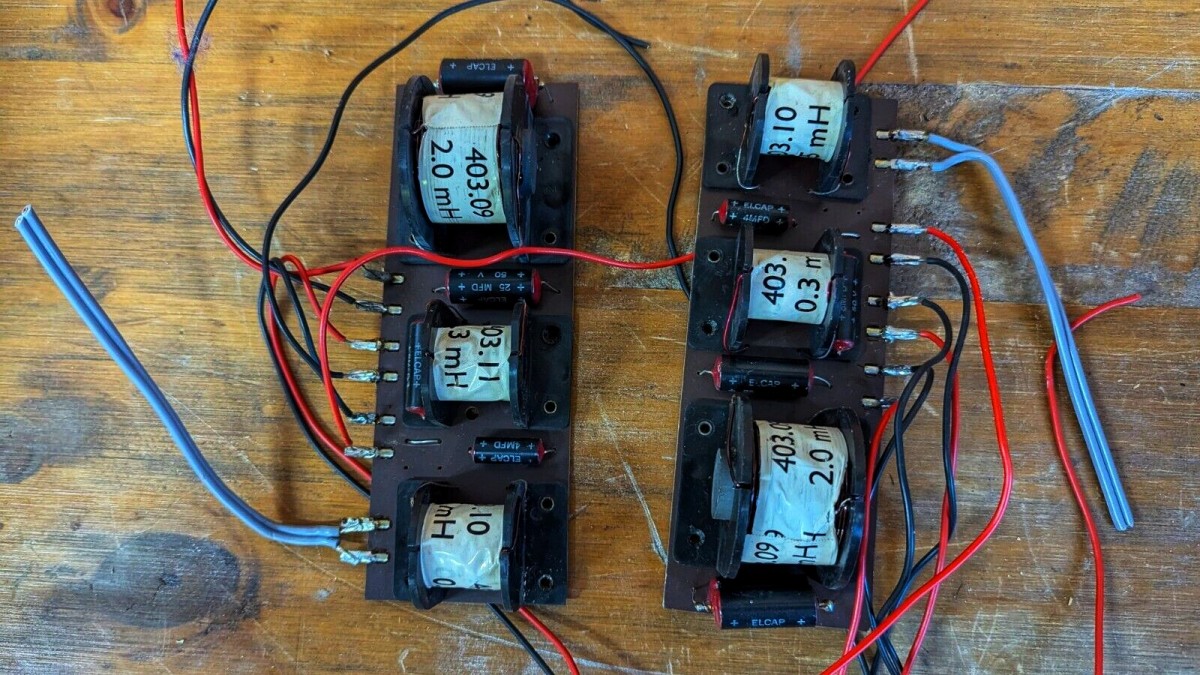
Have sent them a message asking what the third one is...
I did wonder if that was the value, but didn't want to assume the squiggle was actually a 5 with nothing else in front of it.It is likely to be 0.5 mH. You can make out the "0" on one and the "5" on the other.
The tweeter in the Triton i restored was a Philips ad0160 OEM variation with the blue dome. When i researched it it seems that some different model tweeters were used in these speakers, but mosttly Philips made and did not have ferrofluid like the classic Philips AD0160
That's interesting! I've only seen images of the Triton 3 that include the Wharfedale purple dome tweeter.
Can you remember the source of your information?
Wharfedale rarely used other manufacturer's drivers. One notable exception was in the E series which utilised a Japanese Foster horn tweeter.
Can you remember the source of your information?
Wharfedale rarely used other manufacturer's drivers. One notable exception was in the E series which utilised a Japanese Foster horn tweeter.
Last edited:
🤯 that watermark looks like a website I need to remember then... Thank you.Wonder no more!
A retired Philips engineer who worked on those drivers in the former philips speaker factory in Dendermonde, Belgium (now independent OEM builder called Premium Sound Solutions). The man died a few months ago (at high age), but i contacted him 25 years ago trough a mutual friend about this. He became a friend and learned me most of what i know about speaker design and so. That warfdale I repaired belonged to a family member and was probally the first speaker i did repair myself.That's interesting! I've only seen images of the Triton 3 that include the Wharfedale purple dome tweeter.
Can you remember the source of your information?
Wharfedale rarely used other manufacturer's drivers. One notable exception was in the E series which utilised a Japanese Foster horn tweeter.
I went back to my notes, and it seems that the blue tweeter was only used very short in 1971 and sold in Belgium and the Netherlands, and was a dome, and that the purple was replacing it soon and was a small cone tweeter, also made by Philips but fully OEM (only for Warfedale). So yours is a later model probally. That is the Triton most know. The tweeter in the early version was not that good that guy said, it was crossed to low to meet the other drivers.
I know i repaired it, but the tweeter never sounded good again (probally damaged) and so the speakers were sold by the father of the friend who owned them. They were replaced by a pair of big 3 way Onkyo monkey coffins (don't ask me the model, it's 25 years ago). Philips speakers, and speakers with philips drivers were very popular down here in the 1960's and 1970's as they were largely made in Belgium in different factories like the one in Dendermonde.
I know i repaired it, but the tweeter never sounded good again (probally damaged) and so the speakers were sold by the father of the friend who owned them. They were replaced by a pair of big 3 way Onkyo monkey coffins (don't ask me the model, it's 25 years ago). Philips speakers, and speakers with philips drivers were very popular down here in the 1960's and 1970's as they were largely made in Belgium in different factories like the one in Dendermonde.
- Home
- Loudspeakers
- Multi-Way
- Wharfedale Triton crossover